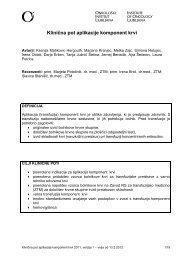Create successful ePaper yourself
Turn your PDF publications into a flip-book with our unique Google optimized e-Paper software.
The effect of electrochemotherapy on microcirculatory<br />
blood flow in a subcutaneous tumour model as assessed<br />
with laser Doppler flowmetry<br />
Toma` Jarm 1 , Ajra [e~erov 2 , Maja ^ema`ar 2 , Simona Kranjc 2 , Damijan<br />
Miklav~i~ 1 , Gregor Ser{a 2<br />
1<br />
University of Ljubljana, Faculty of Electr. Eng., Tr`a{ka 25, SI-1000 Ljubljana, Slovenia; 2<br />
Institute of Oncology, Zalo{ka 2, SI-1000 Ljubljana, Slovenia<br />
Electrochemotherapy (ECT) with bleomycin (BLM) is a potent local antitumour<br />
treatment. The uptake of the drug in tumour cells is greatly enhanced by formation<br />
of transient pores in the cell membrane; a phenomenon called electroporation (EP)<br />
which is induced by local application of special very short but high-voltage electric<br />
pulses. The effectiveness of ECT has been demonstrated in numerous animal studies<br />
as well as in various clinical studies. It has been demonstrated that this antitumour<br />
effectiveness might be partially also due to the effects on tumour blood flow. In the<br />
present study we are investigating the time- and frequency-domain characteristics of<br />
microcirculatory blood flow in tumours during the first hour after treatment.<br />
Blood flow was measured in solid subcutaneous Sa-1 fibrosarcoma tumours growing<br />
in the right flank of immunocompetent A/J mice. The mice were divided in four<br />
groups: BLM treatment (dose 20 µg/mouse, i.v. injection), EP treatment (8 pulses,<br />
duration 100 µs, amplitude 1300 V/cm, repetition frequency 1 Hz), ECT treatment<br />
(BLM treatment followed after 3 minutes by EP treatment), and control (sham)<br />
treatment. Local blood flow in tumours was monitored before, during and for one<br />
hour after therapy by means of laser Doppler flowmetry (LDF; OxyFlo2000, bare<br />
fibre sensors, Oxford Optronix, U.K.). The mice were anesthetised using isoflurane<br />
and their physiological temperature was maintained artificially throughout the<br />
experiment.<br />
40l25<br />
The injection of BLM alone or physiological saline (control) produced no significant<br />
change in microcirculation of tumours. On the other hand, in EP and ECT groups a<br />
practically complete shutdown of blood flow has been found within a few seconds<br />
after application of EP thus indicating a dramatic vasoconstriction. After a few minutes<br />
a partial reperfusion commenced. The increasing was relatively rapid during the first<br />
couple of minutes but it slowed down later on. In most tumours this increasing<br />
was observed for about 20 minutes after the treatment with the blood flow never<br />
reaching the pre-treatment level. In many (but not all) cases blood flow started to<br />
decrease slowly again afterwards. The level of blood flow in all EP- and ECT-treated<br />
tumours at the end of observation was significantly below the pre-treatment level<br />
in spite of relatively large heterogeneity in the pattern of blood flow changes. No<br />
systemic differences between EP- and ECT-treated tumours were found within the<br />
first hour after the treatment.<br />
The present results are in agreement with previously reported reduced blood flow in<br />
tumours within hours following the application of EP pulses. However, no previous

















